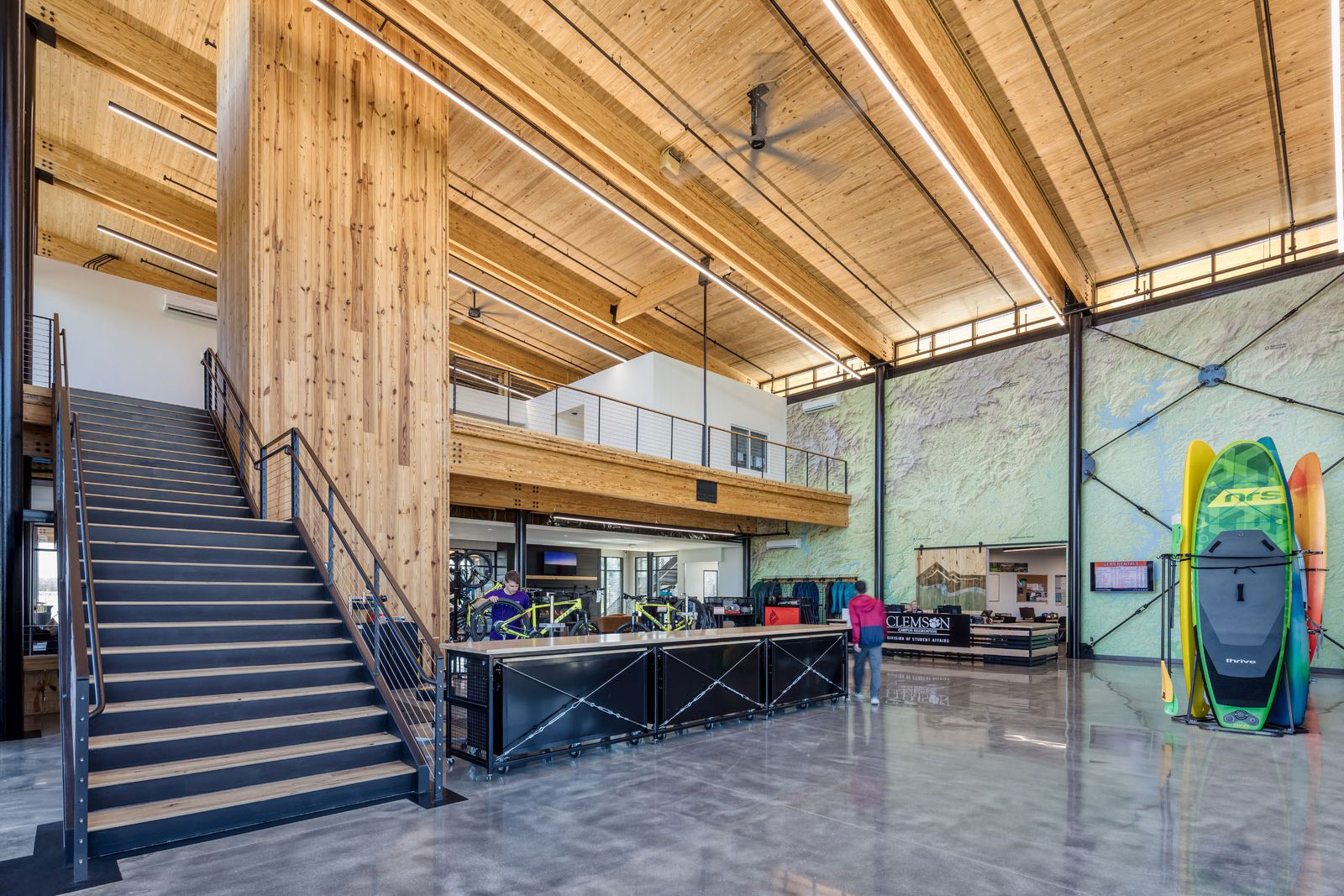Story at a glance:
- Wood is a key element of biophilic design, as it reduces stress in built environments.
- Using sustainable wood can help you gain LEED certifications and even reach net-zero.
- Materials like reclaimed wood help reduce waste in the industry.
How is wood sustainable? Wood is reusable, allows us to reduce waste, and we have more of it than we think, according to the USGBC.
Wood is increasing in demand across the industry. In a study done by Science Direct, it was found that the annual demand for engineered wood products (EWP) materials up to 2030 is expected to range up to 23,707 kilotons and 30,933 kilotons per year. “Three development trends can potentially lead to a higher share of wood construction in the future: (a.) technical progress towards high performing load-bearing wood constructions, (b.) progress in the harmonization of fire protection and environmental regulations, (c.) constant growth in the capacity to produce ecological construction materials,” the study said.
Wood also has a carbon footprint that’s 75% less than concrete or steel. With innovative design, we can optimize the materials we use to reduce the amount of waste we produce per job site. Excess wood can then be taken to recovery centers for recycling, where another builder can secure wood for his or her next project… all without tapping our forestlands for materials,” the USGBC says. “Since the 1940s, forest growth in the United States has continually exceeded harvest, which means we use much less wood than we think we do. And, of the 750 million acres of forestland in the United States, about 20% of it is protected by conservation efforts. So, all in all, we’re in very good shape to continue using wood as our main building material.”
It supports biophilic design.
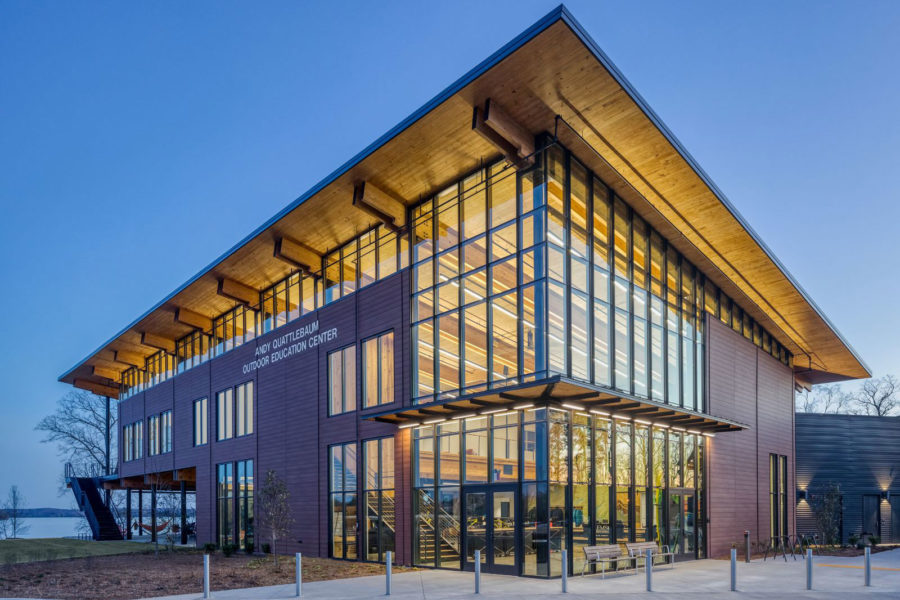
The Andy Quattlebaum Outdoor Education Center at Clemson University, a 2021 WoodWorks Design Award winner. Photo by Jonathan Hillyer
Part of the reason wood has had a resurgence in the market is because of its health benefits. Wood can be a beautiful element of biophilic design as it brings nature indoors. Using wood in a sustainable way will not only help create better buildings and work spaces, but it’s also said to make people happier. Recent studies have shown that designing with wood in office spaces can increase productivity by 8% and well-being satisfaction by 13%. The use of wood in interior spaces is a key part of biophilic design, making nature feel accessible in a variety of environments.
Wood supports biophilic design because it’s hypoallergenic, promotes good air quality, moderates humidity and temperature, and also has acoustic capabilities.
Companies like Microsoft are using wood as a key element in their biophilic design. The tech mogul introduced offices in the trees in 2017. “These rustic cabin-like wood structures in the trees come complete with many of the modern necessities of an office: electricity, meeting spaces, Wi-Fi access and ergonomically designed seating. Hand-carved wooden doors open at the swipe of a badge to a selection of meeting spaces,” according to Think Wood.
It can help you earn certifications.
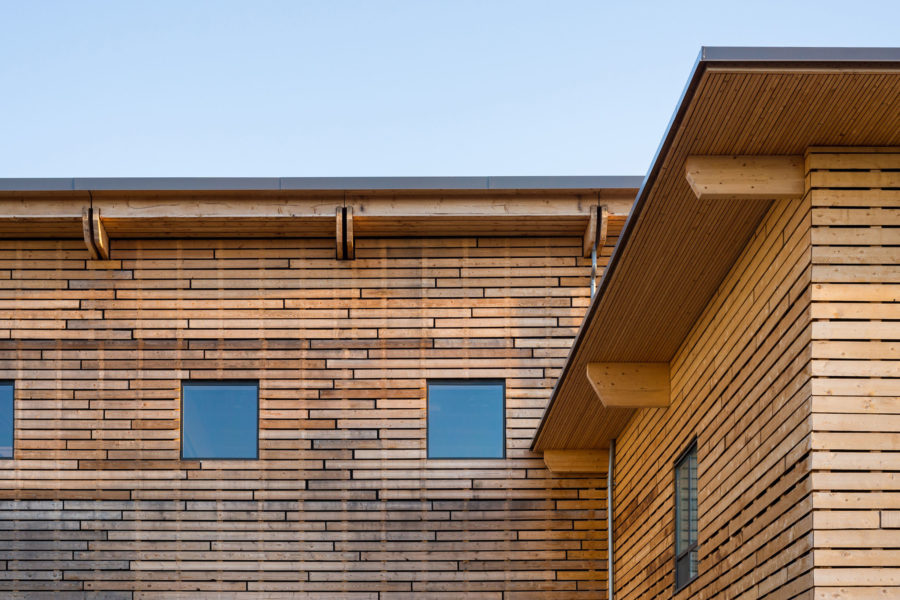
Photo courtesy of StructureCraft
Wood can also contribute to LEED certification or even be used to achieve net zero.
One example of this can be found in ZAS Architects and Bucholz McEvoy Architects’ project, the headquarters for Toronto and Region Conservation Authority’s (TRCA). In addition to the use of wood and an energy-efficient building envelope, this project implements a green roof, rainwater harvesting, low impact landscape development, and solar chimneys. The project is also targeting Net Carbon Zero, LEED Platinum V4, Toronto Green Standard Level 2, and WELL Silver certifications.
“In the LEED 2009 commercial rating system (NC, CI), the Certified Wood (MRc7) offers a single point if at least 50% by cost of permanently installed wood products are FSC-certified. Under the LEED 2009 system, projects can be rewarded for the FSC credit even if wood is a relatively minor part of the overall materials used,” according to the FSC.
Sustainable wood can also help builders achieve net-zero. This can be implemented in both residential and commercial space, as wood emits less carbon and doesn’t take as much energy to harvest as steel or concrete. Wood also works to reduce chemicals in the atmosphere, as well as carbon storage. According to a study done by Science Direct, “mass timber buildings emitted on average 216 kg CO2e/m2 less in construction phase than their counterparts constructed using conventional building materials.”
It’s renewable.
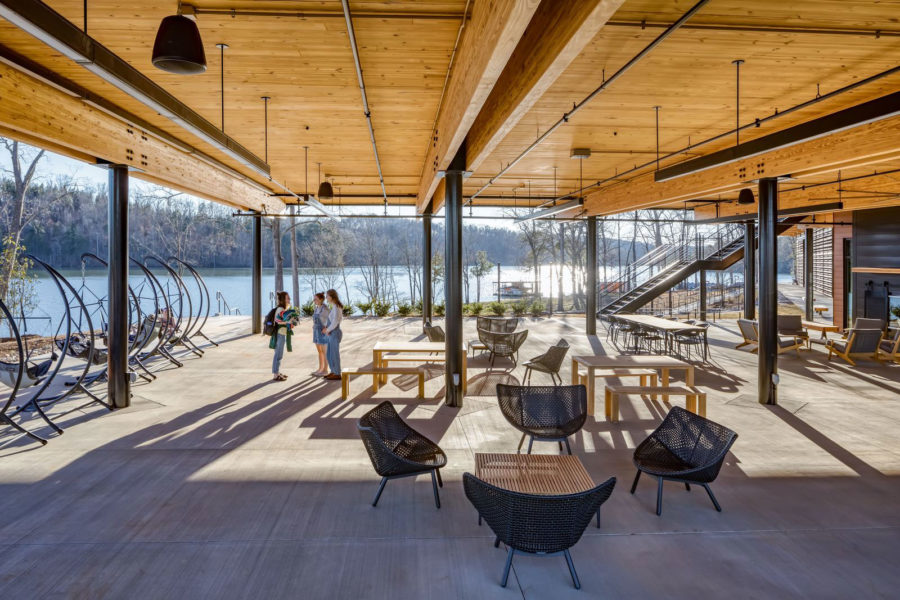
Photo by Jonathan Hillyer
You might also consider wood for its renewable power. It’s no secret that deforestation plays a large part in our current climate crisis, but the beauty of wood is that it is the only building material grown from the Earth.
Although wood is renewable, it is crucial to grow and harvest lumber responsibly. Forestry management is a key element to consider when building with wood. “Strong markets for wood products encourage forest owners to keep their lands as forests and invest in practices to keep trees healthy. Forest management in the US and Canada operates under federal, state, provincial, and local regulations to protect water quality, wildlife habitat, soil and other natural resources. In the US more forest land is lost to development, then forestry,” Think Wood says.
Despite development being a contributor in deforestation, there are ways to use wood responsibly while supporting existing forests. Using certified sustainable wood is one way AEC professionals can ensure their projects are working to support ethical forest management.
“When shopping for wood, consumers often look to certified wood to ensure that they’re purchasing wood products that are, in fact, sourced from sustainable forests,” the USGBC says. “This is important because these programs keep consumers and retailers in line when it comes to forestry practices. The more consumers demand sustainable products, the more retailers and forest managers shy away from destructive harvesting practices like clear-cutting and logging.”
It reduces waste.
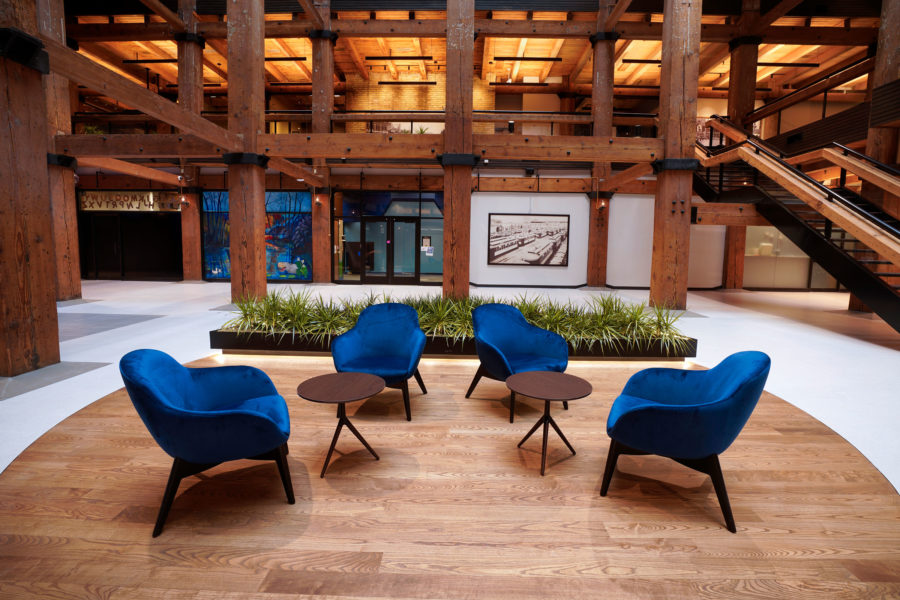
Butler Square. Photo courtesy of Butler Square
Using sustainably sourced wood also reduces construction and demolition (C&D) waste when a building has reached the end of its life. Materials like concrete and steel are more difficult to recycle and reuse. “The built environment is the world’s largest consumer of raw materials by sector and produces significant construction and demolition waste,” Think Wood said in a previous contribution to gb&d. “In 2018 alone the US generated 600 million tons of C&D debris—more than twice the amount of municipal solid waste picked up from homes and businesses.”
Think Wood goes on to say, “Maximizing wood use in both residential and commercial construction could remove an estimated 21 million tons of C02 from the atmosphere annually – equal to taking 4.4 million cars off the road.”
One of the benefits of using a natural building material like sustainable wood is how it supports a circular economy. A circular economy is a model of production and consumption that emphasizes reusing, repairing, refurbishing, and recycling existing materials and products as long as possible. Wood is one of the greatest assets we have as we shift to this more sustainable model.
One way to reduce waste is through factory-built prefabrication or mass timber, both of which can optimize assembly and streamline onsite erection. Mass timber is a growing market with the International Code Council (ICC) approving new proposals every year. This allows projects to expand into bigger and taller commercial buildings as well as residential. The use of mass timber can be found in projects like Milwaukee’s Timber Lofts, which reimagine existing buildings and make them greener.
It can be reused and reclaimed.

Decades-old barn sourced for reclaimed barn wood by Woodstock Walls. Photo courtesy of Woodstock Architectural Products
Another pillar of wood sustainability is its potential for reuse and reclamation. Reclaimed wood can be used across a variety of projects, including for walls, flooring, architectural panels, moulding, doors, countertops, tables, shelves, beams, and ceiling panels.
Reclaiming wood reduces the demand for harvesting new timber and minimizes deforestation. Reusing and reclaiming wood allows AEC professionals to participate in one of the most sustainable practices of the built environment. But how should we go about this process of upcycling?
“Reputable manufacturers source century-old barn wood and examine the structures themselves,” said Kevin Fults, founder of Woodstock AP, in a previous article for gb&d. “For example, at Woodstock Walls, the owner takes trips through the back countries of southern and Midwest states to find the highest quality reclaimed wood free from decomposition, bugs, and mold.”
Reclaimed wood is also another source that can help improve the health and quality of spaces. Wood is naturally absorbent and acts as an insulator with air pockets in its cellular structure that help slow the conductivity of heat. It also doesn’t hurt that reclaimed wood provides unique interior and exterior designs, as no two pieces look the same.
It’s easy to modify.
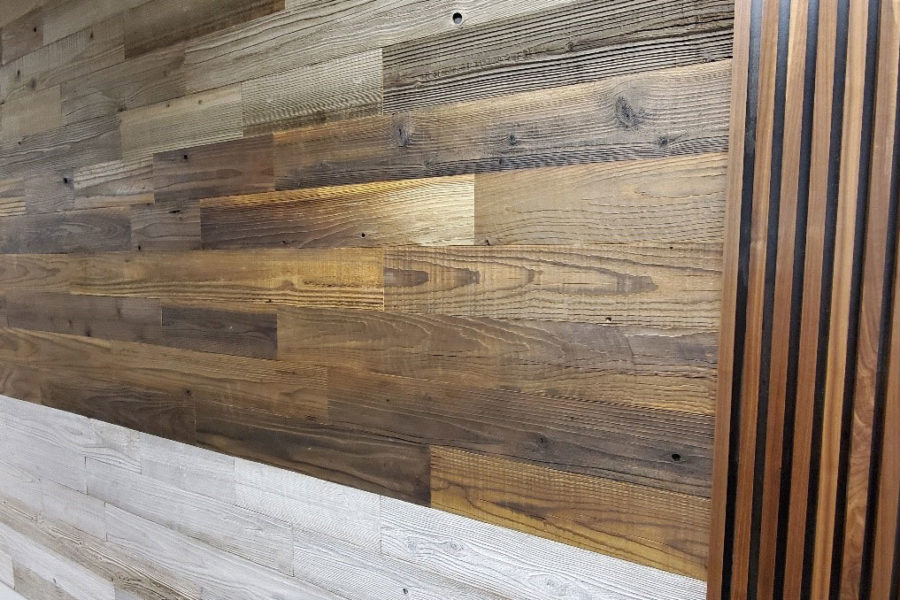
Custom reclaimed wood wall panels with Woodstock AP tannin solution. Photo courtesy of Woodstock Architectural Products
Wood is also sustainable for its potential for modification.
Cross laminated timber (CLT) is one of the most popular forms of modified wood on the market. CLT is a solid wood panel made from layering boards in alternating directions that are bonded together with structural adhesive. This fusion process creates a lightweight yet extremely strong building material that is also fire- and earthquake-resistant. This sought-after material allows for quicker construction as it can be prefabricated, as well as quicker clean up and waste reduction.
Architects may also turn to thermally modified wood to ensure durability and performance. Thermal modification enhances wood by making it rot- and moisture-resistant. This process is sustainable because there are no chemicals or plastics used in the process, just heat and steam. Minimal energy is used as the process only takes a couple of days, instead of kiln-drying that can take several weeks.
It’s often chemical-free.
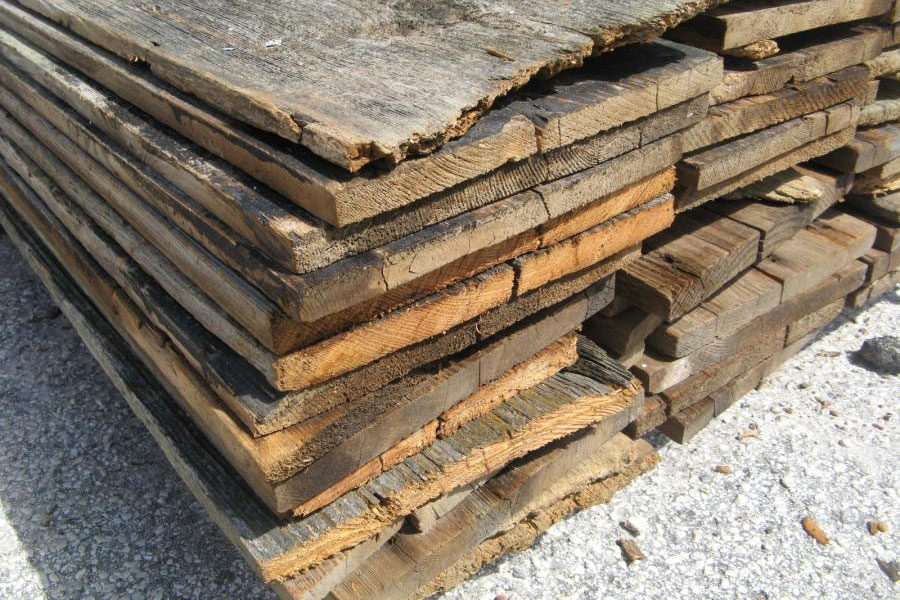
Raw and unfinished authentic reclaimed barn wood planks. Photo courtesy of Woodstock Architectural Products
One of the biggest upsides to using wood as a sustainable building material is that it is often free of harmful chemicals. While chemically treated wood exists, architects looking for a greener option can easily consider chemical-free wood options. Whether that means using wood with tannins, using thermally modified wood, or looking for reclaimed pieces, there are plenty of chemical-free choices.
Woodstock Architectural Products is a leader in custom woodwork and specializes in tannin solutions, reclaimed wood, and more. Tannin is a natural chemical found in wood that protects against bacteria and fungi growth. These tannin solutions can alter the color of wood while still maintaining its natural characteristics and texture.
Tannin solutions use tannic acid that can be extracted from bark, wood, stems, and leaves to dye other surfaces. When the compound is mixed and applied on certain wood species, the reaction exposes multiple shades of brown, black, and red.
Using chemical-free wood and wood treatment options also means a more sustainable life cycle for the material. When wood products free of chemicals are used in the built environment, the options for reuse are increased and the demolition waste is less harmful.

